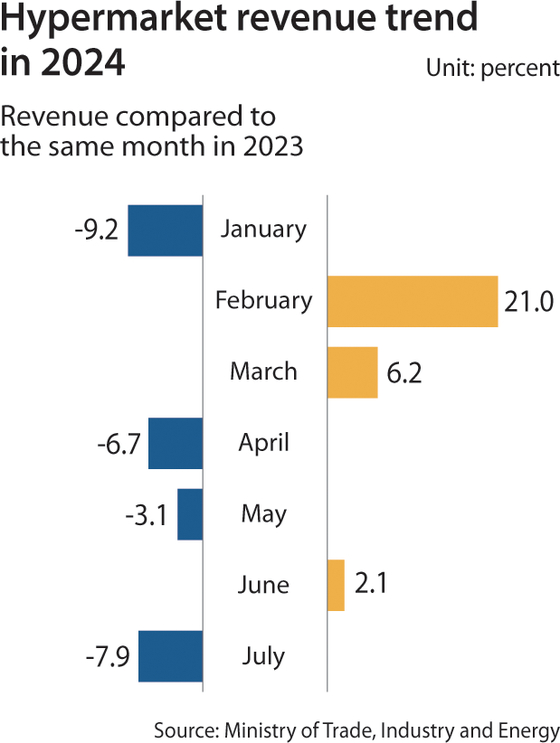Explainer: Why daily necessities are disappearing from Korean superstores
Published: 14 Oct. 2024, 06:00
-

- CHO YONG-JUN
- cho.yongjun1@joongang.co.kr
![The produce section at a Homeplus Mega Food Market in Gangseo District, western Seoul [CHO YONG-JUN]](https://koreajoongangdaily.joins.com/data/photo/2024/10/14/47cc2a70-b137-438f-872d-7af17d66b382.jpg)
The produce section at a Homeplus Mega Food Market in Gangseo District, western Seoul [CHO YONG-JUN]
Korea’s economic and business scenes unfold in such an intricate way that the headline numbers and official statements fall short of explaining what is really happening and why it matters. The Korea JoongAng Daily’s Explainer series aims to address the largely-unmet yet crucial need with an angle relevant to our readers across the globe. — ED
Customers are greeted by a vast range of fresh vegetables, tasty fruits, meats and kimchi, followed by all sorts of instant noodles, snacks and ready meals when they walk into a Homeplus branch in Gangseo District, western Seoul.
What’s surprisingly difficult to find are the nonfood items — daily necessities like detergents, soaps, and different types of cases are mostly out of sight, hidden in a back corner of the store.
The phenomenon is becoming more and more common across Korea's biggest stores. The country's “hypermarkets” — sprawling, multilevel discount marts, with similarities to North America's “superstore” category that includes Walmart and Target — have been characterized, in the past, for selling literally everything, with both food and nonfood products front and center.
But that's not true anymore.
For the past couple of years, Korea's three major hypermarket chains — Homeplus, Emart and Lotte Mart — have been shifting further away from the sell-everything concept that once defined them and closer to a focus on food and groceries, making the lines that define the category much fuzzier.
The change in focus is a result of hypermarkets’ failure to maintain price competitiveness in selling many industrial products following the rise of Coupang and, more recently, AliExpress. Coupang’s mobile app had roughly 35.24 million installs as of August of this year while AliExpress logged 14.29 million, according to market tracker WiseApp, Retail, Goods. Many consumers, nowadays, turn to Coupang, which delivers products directly to their doors via its next-day Rocket Delivery service, or to China's AliExpress, which sells household goods at prices far lower than anything seen in retail shops.
And then there's Daiso, to which customers are increasingly flocking instead of hypermarkets. Daiso began as a dollar store selling cheap and mostly Chinese-made products for 1,000 won (70 cents) to 3,000 won. The country's 1,500 Daiso branches have now solidified the brand's status as the go-to offline source for anything relatively affordable, from simple office supplies to storage products and budget-friendly cosmetics. Daiso's yearly revenue reflects that trend: It recorded 3.46 trillion won in revenue in 2023, a significant increase from the 1.979 trillion won it recorded in 2018 and 2.946 trillion in 2022.
And stores like Homeplus are feeling the squeeze: Hypermarket revenue during July decreased 7.9 percent from the same period of last year, according to statistics the Industry Ministry released in late August. Convenience stores saw a 2.9 percent increase while "super supermarkets" — supermarkets run by large retail companies such as Emart Everyday, Homeplus Express and GS The Fresh — rose by 1.4 percent.
The same trend is evident throughout the country's economy — industrial production currently accounts for a smaller portion of its total output than the service sector does, according to recent Bank of Korea data.
Hypermarkets seem to think that produce is the sector where they can still compete. Homeplus, for instance, introduced Mega Food Market that, as its name suggests, focuses on food sales, in 2022. It also aims to make groceries account for 80 percent of its shelves, a source at MBK Partners — which owns HomePlus — told the Korea JoongAng Daily. Emart and Lotte Mart, too, have renewed their existing branches as Starfield Market and Grand Grocery stores that emphasize food and groceries.

Hypermarket revenue trend in 2024
Why are Korean consumers buying fewer products from hypermarkets?
Hypermarkets were largely price-competitive against traditional e-commerce platforms such as 11Street and Gmarket — back when they were charging 3,000 won for delivery.
But after Coupang began rolling out Rocket Delivery in 2014, offering faster speed at lower cost, purchasing on the platform began to make much more sense. For example, a pack of 12 Monami 153 pens costs 3,140 won on Coupang with monthly Rocket WOW subscribers entitled to “free” next-day delivery. Conventional retailers, by contrast, would charge a flat 3,000 delivery fee no matter how many pens were purchased.
A no-nonsense but off-brand protective case for an iPad Pro costs 31,900 won at Emart as of press time. A very similar — and also off-brand — iPad Pro case, with 316 reviews and a 4.6 rating, costs just 5,578 won on AliExpress. Buying on AliExpress just makes more sense.
Korean customers, in fact, use AliExpress mostly to purchase merchandise including stationery, office supplies, electronics, sporting goods, camping items and car appliances. Those same consumers were largely purchasing those items from hypermarkets just a few years ago, according to AliExpress Korea's internal data.
“Korean consumers have also shown very high satisfaction rates in clothing and fashion-related categories, day-to-day items and general manufactured goods,” AliExpress Korea told the Korea JoongAng Daily.
The numbers show, as AliExpress app users in Korea have almost quadrupled in the past three years — rising from 2 million a month in April 2021 to almost 9 million this year — according to WiseApp.
“Korea is a small country, naturally allowing for faster delivery time,” Jeon Mi-young, a research fellow at the Consumer Trend Center at Seoul National University, told the Korea JoongAng Daily.
Jeon highlighted the popularity of Korea's “quick delivery” services, referring to quick intracity deliveries performed on motorbikes, and Baedal Minjok’s B Mart, which delivers all kinds of commodities and even electronics in less than 30 minutes.
“So consumers don't really need to buy commodities in offline stores.”
![Nonfood products are relegated to a few small sections of a Homeplus Mega Food Market in Gangseo District, western Seoul. [CHO YONG-JUN]](https://koreajoongangdaily.joins.com/data/photo/2024/10/14/b42df01d-ba65-4b43-993c-3f8d5f1c0642.jpg)
Nonfood products are relegated to a few small sections of a Homeplus Mega Food Market in Gangseo District, western Seoul. [CHO YONG-JUN]
How are hypermarkets adapting?
By taking industrial products off the shelves and focusing on grocery sales. The tight distribution network of fresh products that hypermarkets have built over decades gives them an upper hand in fresh, chilled food and frozen foods.
The three big names — Emart, Lotte Mart and Homeplus — have been testing out a new type of hypermarket since last year. The category includes Lotte Mart's Grand Grocery in Eunpyeong District, northern Seoul, 90 percent of which is devoted to groceries; Homeplus's Mega Food Market; and Emart's Starfield Market Emart Jukjeon in Yongin, Gyeonggi.
Homeplus has converted 31 of its branches to Mega Food Markets in the past two years — a "hypermarket of the future,” as the company calls it. The Mega Food Markets are also showing good numbers, as the grocery revenue in the revamped stores increased 95 percent year over year in 2023, according to Homeplus.
![Homeplus Mega Food Market in Gangseo District, western Seoul [CHO YONG-JUN]](https://koreajoongangdaily.joins.com/data/photo/2024/10/14/ad2ba80a-06c1-4185-a965-9ea513012ec0.jpg)
Homeplus Mega Food Market in Gangseo District, western Seoul [CHO YONG-JUN]
“Grocery is the way offline hypermarkets can survive in the current retail industry,” a Lotte Mart spokesperson told the Korea JoongAng Daily regarding Grand Grocery.
Lotte Mart attributed its advantage over e-commerce platforms in the grocery sector to the “quality” of its fresh food range, with fresh crabs as an example: It's able to sell the crustaceans in its physical stores while they're still alive, while a delivery service would need to sell their frozen, dead counterparts. The company's Eunpyeong District branch saw a 10 percent increase in terms of revenue and customer count in the second quarter of this year from the same period of 2023.
Emart downsized its Jukjeon branch — once its highest-grossing location — from 20,000-or-so square-meters (213,500 square feet) to 6,600 square meters but kept 80 percent of its grocery shelves, claiming the arrangement would provide a “more streamlined experience.”
“Emart believes that people prefer to buy groceries in offline stores,” Emart’s spokesperson said, adding that the company has the upper hand in “freshness, price competitiveness and know-how” when it comes to grocery and food sales, emphasizing that it purchases ingredients directly from farms and is “less affected by price changes in the market” as a retailer who purchases items in bulk.
The company maintains that it is able to gain a better deal than other retailers because it runs the Emart brand as well as wholesale retailer Emart Traders and supermarket chain Emart Everday and purchases in bulk for all three.
What nonperishable products remain on sale, which a traditional Emart would once have sold in-house, are now largely in third-party shops that the branch houses, including an Olive Young cosmetic store, a Hanssem furniture area, a Youngpoong Bookstore and even a Daiso.
But aren't people also buying groceries online?
Yes, they are, and that's likely going to be a problem for hypermarkets.
Consumers were not previously buying food online as often as they were buying other goods. That's starting to change, however — people are now buying food more. On a survey released the Seoul Metropolitan Government released in April, some 65.5 percent of respondents selected food as the they most often purchased onlinelast year, making 2023 the first year that food purchases overtook clothing and fashion category.
When the e-commerce platforms were first popularized in Korea in the early 2010s, many were hesitant to buy clothes online, fearing that they might get the wrong colors or wrong sizes — an issue that consumers largely neglect these days with the rise of color-accurate monitors, size guides and easy refunds and exchanges. A similar trend may apply to groceries.
“If the generation that is used to buying everything online tries out online grocery shopping and is satisfied with the result, more and more might shift to buying groceries online,” research fellow Jeon said, adding that products like cherry tomatoes and blueberries, for which the quality of an individual berry matter less, might be “safer” to buy online.
“But things like catching a live fish and slicing it in front of your eyes? That, you can’t do it online.”
BY CHO YONG-JUN [cho.yongjun1@joongang.co.kr]










with the Korea JoongAng Daily
To write comments, please log in to one of the accounts.
Standards Board Policy (0/250자)